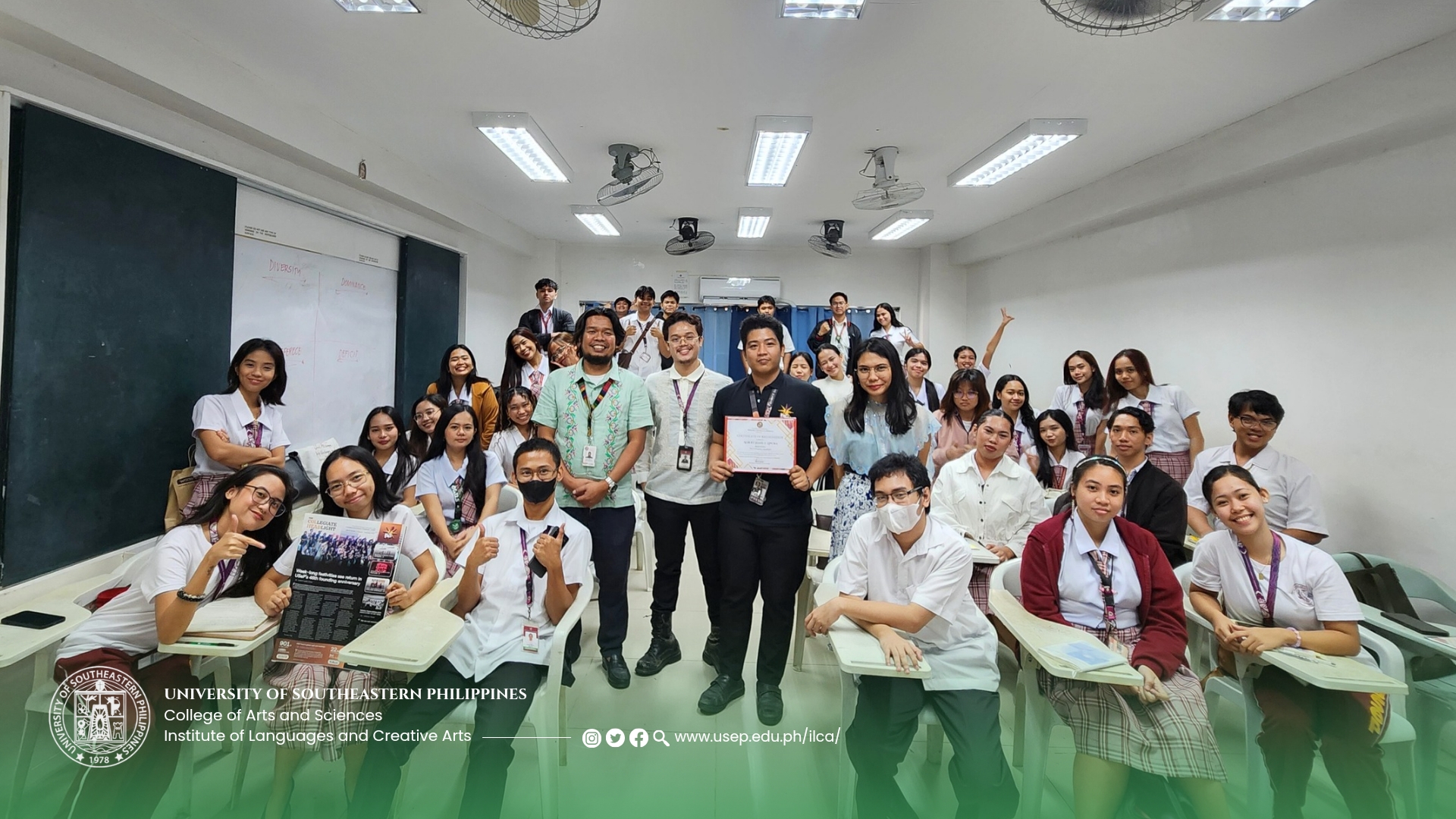Through a lecture series by The Collegiate Headlight (ColHead) representatives, AB English Language students in partnership with the Institute of Languages and Creative Arts acquired firsthand knowledge in news writing and layout design. Held on February 9 and 12, 2025, the sessions were led by Albert Hans Lipura and Roxy Blue De Jesus, News Editor and Layout Artist, respectively.
Lipura introduced students to the basics of news writing, emphasizing objectivity, structure, and engaging storytelling. He highlighted the Inverted Pyramid structure, which places the most
crucial information first, followed by supporting details.
“We decided sa Collegiate Headlight, the first two paragraphs, in a basic news, usually answer the 5Ws and 1H—what, who, when, where, why, and how. (We decided that in The Collegiate Headlight, the first two paragraphs in a basic news article usually answer the 5Ws and 1H.),” he explained.
He also stressed the importance of headlines in capturing readers’ attention. “If pangit ang inyong headline or dili ninyo ma-interest ang readers, dili jud na mabasa inyong article. (If your headline is weak or doesn’t capture interest, your article won’t be read, no matter how well- written it is.)”
When discussing bias in reporting, Lipura acknowledged that complete neutrality is difficult.
His passion for journalism, he shared, was sparked in high school after reading about fact- checking in news articles. “I fell in love with journalism when I was in high school. I read something about them making a news article na nag fact-check sila og people. I noticed na daghan kaayog ma misinform or mabiktima ng fake news. (I fell in love with journalism in high school when I read an article about fact-checking. I realized how many people get misinformed or become victims of fake news.)”
Throughout the lecture, he reinforced ColHead’s commitment to delivering accurate and verified news to prevent misinformation within the University.
Lipura also shared a real-life experience on handling threats as a journalist. “Naay nagsugod sa office but we stood by our information. I always tell my writers to double-check information para if naay mag-question, naa miy secured evidence. (Someone came to our office to intimidate us, but we stood by our reporting. I always tell my writers to double-check information so that if someone questions it, we have secured evidence.)”
On Day 2, Roxy Blue De Jesus shifted the focus to layout and design, explaining how visual elements enhance readability and engagement. “Creation of visual content is key to communicating a message” , he stated.
He shared that ColHead integrates various design elements into its newsletters, broadsheets, and online materials which include lines and shapes for structure and better organization, colors to draw attention and evoke emotions, typography for readability, space to prevent clutter, texture for depth, and rendering for a polished, professional look.
De Jesus emphasized that there is no single best software for layout design, encouraging students to explore different options, with recommendations such as Canva, Adobe Photoshop, and InDesign, highlighting their unique capabilities.
“Experimentation is key when it comes to layout design,” he remarked. “Study, study, study. Ask opinions from other people and learn what software is easier and more convenient to use, he added.
The lectures left a lasting impression on students, including Ms. Ayabi Sugiyama, a Japanese student of AB English Language Program 2, who found the sessions insightful. “The recent lectures taught me valuable lessons that are related to creating news articles. I realized that there are a lot of things to consider when making the contents of the paper since it is important for the article to be able to grab the attention of readers.”
She recognized the complexity of writing news, particularly in structuring content to engage an audience effectively.
For Ms. Celestial Molos, the lectures provided a solid starting point for their work.
“I believe we already have a head start or a good foundation that we can look back on as they already taught us the fundamentals on how to make a newsletter.”
Both students emphasized how the training equipped them with the necessary skills to approach their future writing tasks more confidently.
The two-part lecture from ColHead gave AB English Language students practical knowledge in both the writing and visual presentation of news.
From crafting compelling leads to choosing the right colors, students gained insights into the balance between content and design in journalism.
Through the partnership between the AB English Language Program’s Language Students Society and the USeP Institute of Languages and Creative Arts, this initiative became a reality.
AB English Language Program Head Assoc. Prof. Sajed Ingilan, acknowledged the publication’s dedication, stating, “The Collegiate Headlight is just a one call away, a testament to their commitment to serving the students. May this engagement with them inspire the AB English Language students to write for our peoples.”
With The Collegiate Headlight continuously training young writers and designers, the next generation of journalists is being equipped with the skills to inform, engage, and realize their purpose: to serve the people.
Article and Photos by: Henli Arvey Asueros


